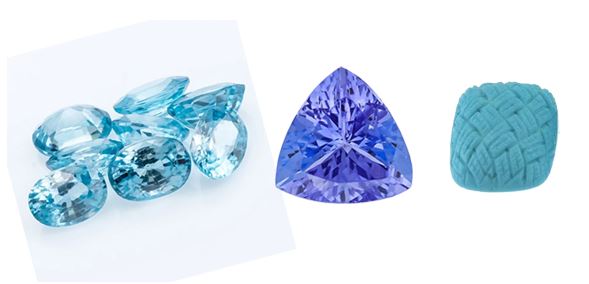December's Birthstone: Zircon, Tanzanite & Turquoise
- by Shop RMC
-

The winter blues have nothing on December’s birthstones: tanzanite, zircon, and turquoise—all three are best known for their beautiful shades of blue.
If you had to pick one December birthstone, which would it be: tanzanite, turquoise or zircon? From the blue to bluish purple of tanzanite, to the intense blue and green of turquoise, to the rainbow varieties of zircon – there’s a color for everyone. If blue is what you’re looking for, all three December birthstones have their own unique take on this favorite hue. Whatever your color, style or budget preferences may be, we can help you pick the right December birthstone for you or a loved one.

ZIRCON BIRTHSTONE MEANING & HISTORY
The origins of the word “zircon” have elicited colorful debate. Some scholars believe it comes from the Arabic word zarkun, meaning “cinnabar” or “vermilion.” Others think the source is the Persian word zargun, or “gold colored.” Considering the broad color palette for this December birthstone – red, orange, yellow, brown, green and blue – either derivation seems possible. Colorless zircon is known for its brilliance and flashes of multicolored light, called fire, which have resulted in centuries of confusion with diamond.
During the Middle Ages, this December birthstone was thought to lull one into a deep sleep and scare off evil spirits. In the Hindu religion, zircon alternates with hessonite garnet as one of the nine gems of the navaratna. When worn together, the nine gems protect the wearer and bring wealth, wisdom and good health.
Victorians had a fondness for blue zircon. Fine specimens can be found in English estate jewelry from the 1880s.
WHERE IS ZIRCON FOUND?
Sri Lanka's wealth of gems is legendary: Sapphire in various colors, ruby, alexandrite, spinel, tournamline, moonstone and quartz are some of the gem minerals unearthed there. So is the December birthstone zircon. Elahera, a region in central Sri Lanka, is one of the country’s most productive areas. Mountains, jungles and restless streams make for a dramatic landscape.
TANZANITE BIRTHSTONE MEANING & HISTORY
Tanzanite may be a relative newcomer to the world of colored stones, but it was one of the most exciting gem discoveries of the 20th century. Blue stones emerging from Tanzania were identified as the mineral zoisite in 1962. Not until 1967, though, did prospectors locate the primary source for this December birthstone: the Merelani Hills. It was eventually named tanzanite in honor of its country of origin. The tanzanite birthstone is often described as “velvety,” mostly because of its deep and saturated color, which ranges from a pure rich blue to violet, with the blue considered most valuable.
Tiffany & Co. believed that tanzanite had international appeal and became its main distributor. In 1968, Tiffany launched a major advertising campaign to promote it. With its vivid colors, high clarity and potential for large cut stones, tanzanite quickly became a sensation. Today, it is not only a December birthstone, but it is also the gem for the 24th wedding anniversary.
WHERE IS TANZANITE FOUND?
The Merelani Hills of northern Tanzania is the only place on earth where tanzanite is mined comercially. Grass-covered hillsides, scrub brush, rocky soil and an occasional tree form the local landscape. In the major mechanized operations there, thousands of workers recover tanzanite from mines dug over a 100 meters (more than 300 feet) deep into the earth. North of the mines tower the snow-covered slopes of Mount Kilimanjaro.
TURQUOISE BIRTHSTONE MEANING & HISTORY
Turquoise is a semi-translucent to opaque gem that ranges from blue to green and often has veins of matrix (remnants of the rock in which it formed) running through it. This December birthstone has been cherished for millennia. The pharaohs and other rulers of ancient Egypt adorned themselves with it. Chinese artisans carved it more than 3,000 years ago.
The turquoise birthstone was thought to possess many beneficial powers, like guaranteeing health and good fortune. From the 13th century on, it was believed to protect the wearer from falling (especially off horses), and would break into several pieces at the approach of disaster. Hindu mystics maintained that seeing a turquoise after beholding the new moon ensured fantastic wealth.
This turquoise birthstone also played an important role in the lives of Native Americans. The Apache thought turquoise could be found by following a rainbow to its end. They also believed that attaching the December birthstone to a bow or firearm made one’s aim more accurate. The Pueblo maintained that turquoise got its color from the sky, while the Hopi thought the gem was produced by lizards scurrying over the earth.
WHERE IS TURQUOISE FOUND?
Turquoise has been mined in the Nishapur district of Iran for more than 1,000 years. The prized even-colored, intense blue turquoise from this region is dubbed “robin’s egg blue,” “sky blue” and “Persian blue.” Trade professionals now use these terms to describe turquoise of this color – regardless of the source.
Source: https://www.gia.edu/birthstones/december-birthstones







